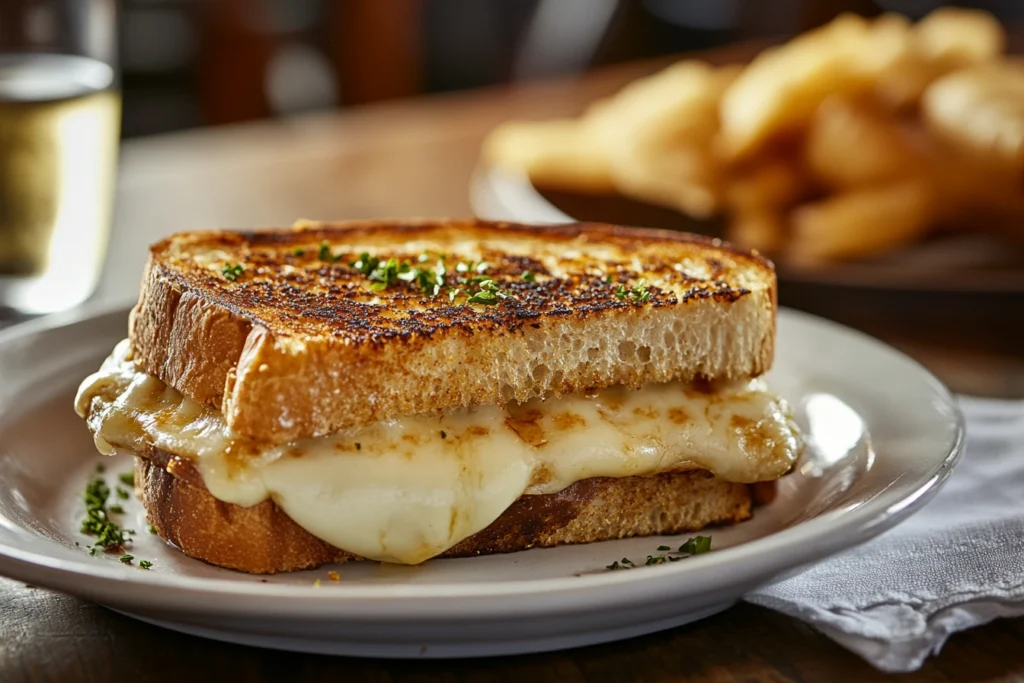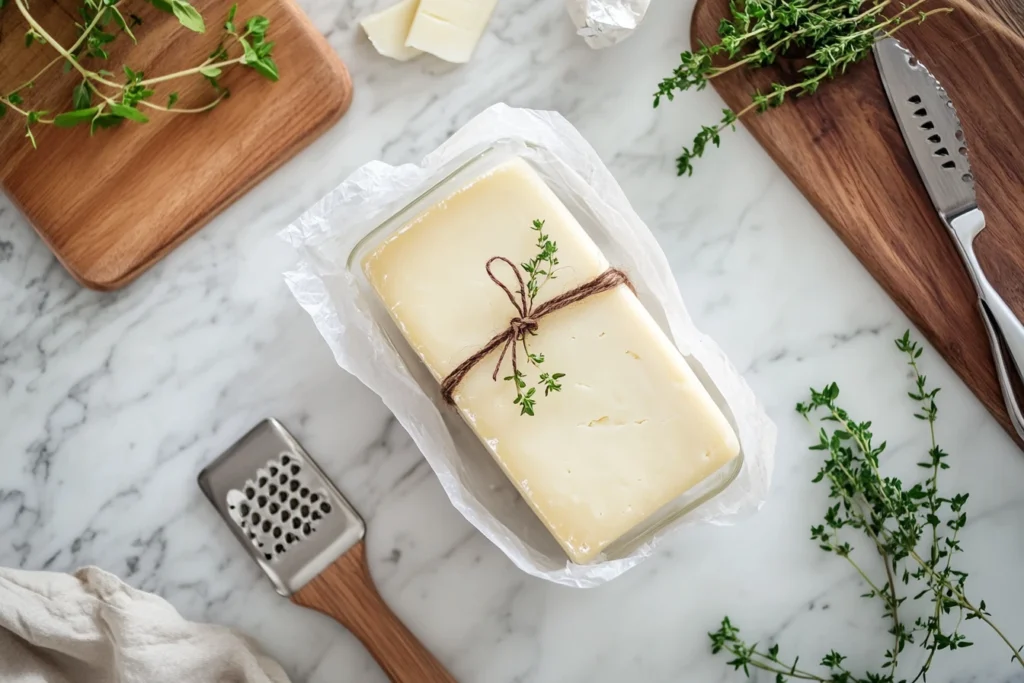1. Introduction to Muenster Cheese
Muenster cheese is a popular semi-soft cheese known for its smooth texture and mild flavor. It features a distinct orange rind and a creamy interior, making it a versatile choice for both snacking and cooking. With its melting properties and buttery taste, it is widely used in sandwiches, burgers, and macaroni dishes.
The origins of muenster cheese are traced back to Alsace, France, where it was traditionally made by monks. However, American muenster, a milder variation, has gained recognition for its adaptability in recipes and family-friendly appeal.
This article explores the history, types, nutritional value, culinary uses, and storage tips of it. It also addresses frequently asked questions to provide a comprehensive guide for cheese lovers and home cooks.
2. History and Origin of Muenster Cheese
2.1 French Roots of Munster Cheese
The history of muenster cheese dates back to the Middle Ages, originating in Alsace, France. Known as Munster cheese, it was first made by Benedictine monks who settled in the region. The monks developed the cheese to preserve milk and sustain communities during winter.
French Munster cheese is a washed-rind cheese, which gives it a pungent aroma and earthy flavor. It was traditionally aged in caves, allowing the flavors to develop naturally. This process created a distinct character, making it popular in European households.
2.2 American Adaptation of Muenster Cheese
In the 19th century, European immigrants brought cheesemaking techniques to the United States, leading to the creation of American muenster cheese. Unlike its French counterpart, American muenster is milder, with a smooth texture and orange rind dyed with annatto for color.
This version quickly gained popularity due to its creamy consistency and mild taste, making it suitable for a wide range of dishes. Today, American version is a staple in delis, burgers, and grilled cheese sandwiches.
2.3 Evolution into Modern Uses
Muenster cheese has evolved from a traditional European delicacy into a modern favorite for home cooks and chefs alike. Its ability to melt easily and blend with other flavors makes it a versatile choice for everyday recipes.
Whether served on cheese boards, baked into casseroles, or melted over vegetables, it remains a timeless favorite for cheese lovers.
3. Types and Varieties of Muenster Cheese
Muenster cheese comes in several varieties, each offering unique flavors, textures, and uses. Whether you prefer a mild and creamy option or a stronger aged version, there is a type of muenster to suit every palate.
3.1 French Munster (Traditional)
French Munster, also known as Munster Géromé, is the original version of muenster cheese. It is made from cow’s milk and has a washed-rind exterior, which gives it a slightly pungent aroma and earthy flavor.
Key characteristics of French Munster include:
- Smooth, creamy interior with a slightly elastic texture.
- Distinct aroma due to the washing process during aging.
- Rich, nutty, and tangy flavor that intensifies with age.
Traditionally, French Munster is served with dark rye bread and paired with fruits or vegetables. Its bold taste also complements wines and sparkling beverages.
3.2 American Muenster (Milder Version)
American muenster is a more modern and milder adaptation of the original French Munster. It is widely produced in the United States and is known for its orange rind, which is colored using annatto.
Key features of American muenster:
- Mild, buttery flavor that appeals to a broader audience.
- Smooth, semi-soft texture, making it perfect for melting.
- Versatile for sandwiches, burgers, and mac and cheese recipes.
Due to its mildness, American muenster is popular with children and is often used in casual and comfort foods.
3.3 Flavored Muenster Cheese
Flavored muenster cheese adds variety to the traditional recipe by incorporating herbs, spices, or smoked elements.
Common flavored varieties include:
- Garlic and chive muenster for added zest.
- Smoked muenster, infused with hickory or applewood flavors.
- Pepper-infused muenster for a spicy kick.
These options are excellent for snacking, appetizers, and pairing with crackers or vegetables.
3.4 Aged vs. Fresh Varieties
Muenster cheese can be enjoyed in both fresh and aged forms, depending on the desired flavor profile.
Fresh muenster:
- Mild and creamy, best suited for melting in hot dishes.
- Ideal for sandwiches, burgers, and grilled cheese.
Aged muenster:
- Stronger, sharper flavor that pairs well with bold ingredients.
- Best served on cheese boards or with cured meats.
4. Nutritional Value and Health Benefits of Muenster Cheese
Muenster cheese is not only delicious but also packed with essential nutrients that make it a valuable addition to a balanced diet. It offers a combination of protein, vitamins, and minerals that promote overall health when consumed in moderation.
4.1 Macronutrients and Calories
It is a rich source of protein and healthy fats.
- Protein: Provides approximately six grams of protein per one-ounce serving, making it ideal for muscle growth and repair.
- Fat: Contains about nine grams of fat per serving, including saturated fats that support energy production.
- Calories: A one-ounce portion delivers approximately 104 calories, making it a satisfying snack or meal addition.
While it is nutrient-dense, portion control is recommended for those managing calorie intake.
4.2 Vitamins and Minerals
Muenster cheese is loaded with vitamins and minerals essential for maintaining good health.
- Calcium: Supports strong bones and teeth, with one serving providing nearly 20% of the daily recommended intake.
- Phosphorus: Works with calcium to promote bone strength and cellular repair.
- Vitamin B12: Contributes to nerve function and red blood cell production.
- Zinc: Boosts immune function and aids wound healing.
These nutrients make it particularly beneficial for bone health, nerve function, and immune support.
4.3 Probiotic Content
Traditional versions of muenster cheese may contain probiotics due to their fermentation process. Probiotics support gut health by promoting the growth of beneficial bacteria.
Benefits include:
- Improved digestion and nutrient absorption.
- Enhanced immune function.
- Reduced inflammation in the gut.
Probiotic-rich cheeses are a great way to add gut-friendly bacteria to your diet.
4.4 Dietary Considerations
Muenster cheese can fit into various diets, but it’s important to consider specific dietary needs.
- Low-Carb and Keto Diets: Its high fat and protein content make it suitable for ketogenic and low-carb diets.
- Lactose Sensitivity: Aged muenster has lower lactose levels, making it easier to digest for some individuals.
- Vegetarian Diets: Most modern versions use microbial rennet instead of animal rennet, but always check the label for vegetarian-friendly options.
For those looking for lighter options, reduced-fat it is available, providing fewer calories and fat while retaining flavor.
5. Culinary Uses of Muenster Cheese
Muenster cheese is highly versatile and complements a wide range of dishes, thanks to its creamy texture and mild flavor. Whether served cold, melted, or baked, it adds richness and depth to recipes.
5.1 Melting Properties and Popular Dishes

Muenster cheese is known for its excellent melting properties, making it ideal for hot dishes and baked recipes.
Popular dishes include:
- Grilled cheese sandwiches where its smooth texture creates a gooey, satisfying bite.
- Burgers and sliders topped with melted slices for added flavor.
- Macaroni and cheese with shredded muenster to achieve a creamy sauce.
- Quesadillas and paninis where it acts as a flavorful, melty filling.
Its ability to melt evenly makes it a top choice for recipes requiring a smooth, creamy consistency. For a deeper understanding of cheese melting, visit this guide to the science of melting cheese.
5.2 Pairings for Muenster Cheese on Cheese Boards
When served cold, it is a standout on cheese boards, pairing well with a variety of ingredients.
Best pairings include:
- Fruits like grapes, apples, and pears to balance its buttery flavor with sweetness.
- Nuts such as almonds and walnuts to add crunch and complement the creaminess.
- Crackers and sliced baguettes that provide a neutral base for tasting the cheese.
- Spreads like honey, fig jam, or mustard for added flavor contrast.
For drinks, it pairs well with sparkling water, apple cider, and light beers. For more pairing ideas, check out this guide to gruyere cheese pairings and storage tips.
5.3 Unique Recipes Using Muenster Cheese
Muenster cheese works well in both traditional and creative recipes, allowing home cooks to experiment with flavors.
Creative recipe ideas:
- Stuffed chicken breast with spinach and muenster for a cheesy filling.
- Cheesy potato gratin layered with slices of muenster for added creaminess.
- Muenster-stuffed meatballs baked to perfection with a melted center.
- Breakfast casseroles combining eggs, vegetables, and melted muenster.
- Savory pastries and puff pastries filled with melted muenster and herbs.
For more cheesy meal ideas, explore these cottage cheese recipes and healthy meals.
5.4 Cooking Tips for Muenster Cheese
To get the best results when cooking with muenster cheese, follow these tips:
- Slice or shred the cheese when using it as a topping for faster and more even melting.
- Allow the cheese to come to room temperature before cooking to improve texture.
- Use fresh muenster for creamy dishes and aged varieties for stronger flavor profiles.
- Combine muenster with other cheeses like cheddar or gouda for a richer flavor blend.
These tips ensure that muenster cheese delivers optimal flavor and texture in every dish.
6. Storage and Preservation Tips for Muenster Cheese
Proper storage of muenster cheese ensures that it retains its flavor, texture, and freshness. Whether used immediately or stored for later, following these tips will help preserve its quality.
6.1 Short-Term Storage of Muenster Cheese

For short-term use, it should be stored in the refrigerator at a temperature between 34–38°F (1–3°C).
Steps for proper storage:
- Wrap the cheese in wax paper or parchment paper to allow it to breathe and prevent excess moisture buildup.
- Place the wrapped cheese in a resealable plastic bag or airtight container for added protection.
- Store it in the vegetable or cheese drawer to maintain consistent humidity levels.
Avoid storing it near strong-smelling foods, as it can absorb odors easily due to its semi-soft texture.
6.2 Freezing Muenster Cheese for Long-Term Storage
Muenster cheese can be frozen, although freezing may slightly alter its texture, making it more crumbly when thawed. It is best suited for melting after freezing.
Steps for freezing:
- Slice or shred the cheese before freezing for easy portioning.
- Wrap portions in plastic wrap and place them in freezer-safe bags, removing as much air as possible.
- Label the bags with the date and store them in the freezer for up to three months.
Thaw frozen it in the refrigerator overnight before use. It is ideal for cooked dishes like casseroles and sauces rather than for serving fresh.
6.3 Identifying Signs of Spoilage in Muenster Cheese
Since muenster cheese is semi-soft, it is more prone to spoilage if not stored properly.
Signs of spoilage include:
- Visible mold growth that appears fuzzy or green.
- A sour or ammonia-like odor, indicating bacterial contamination.
- Slimy or excessively dry texture, showing moisture imbalance.
If mold appears on a block of muenster cheese, cut at least one inch around and below the affected area. However, if mold spreads or if the texture and smell are off, discard the cheese entirely.
6.4 Meal Prep and Pre-Storage Tips
Muenster cheese can be prepped in advance for convenience:
- Pre-slice or shred the cheese for quick use in recipes.
- Portion cheese into meal-sized servings and store them in airtight containers.
- Use grated muenster cheese as a topping for dishes and keep it refrigerated in resealable bags.
These practices save time and ensure the cheese is ready to use for both cooking and snacking.
7. Frequently Asked Questions (FAQs) About Muenster Cheese
7.1 What Is Muenster Cheese Made Of?
Producers make muenster cheese using cow’s milk, pasteurizing it before curdling it with rennet. They press, mold, and age the curds to develop the cheese’s smooth texture and mild flavor. Its signature orange rind gets its color from annatto, a natural dye derived from the seeds of the achiote tree.
7.2 How Does Muenster Cheese Taste?
American version has a mild, buttery flavor with a slightly tangy finish, while the French Munster version has a stronger aroma and earthier taste due to its washed-rind aging process. The flavor intensifies with age, making it suitable for both mild and bold flavor preferences.
7.3 Is Muenster Cheese Healthy?
Muenster cheese is a nutrient-rich food, offering protein, calcium, and vitamins like B12 and phosphorus. These nutrients support bone health, muscle growth, and nerve function. However, it is high in calories and saturated fats, so portion control is recommended for those watching their fat intake.
7.4 Can You Melt Muenster Cheese?
Yes, it melts exceptionally well due to its semi-soft texture and high moisture content. It’s ideal for grilled cheese sandwiches, burgers, quesadillas, and baked pasta dishes. It also works as a topping for soups and casseroles when you want a smooth, gooey finish.
7.5 Is Muenster Cheese Vegetarian-Friendly?
Modern muenster cheese often uses microbial rennet, making it suitable for vegetarians. However, some traditional versions may use animal-derived rennet, so it’s essential to check the label for vegetarian certification if dietary preferences require it.
8. Conclusion
Muenster cheese is a versatile and flavorful ingredient with a rich history that spans from European monasteries to modern American kitchens. Its smooth texture, mild flavor, and melting properties make it a go-to choice for comfort foods, cheese boards, and gourmet recipes.
Beyond its culinary appeal, it offers nutritional benefits, including calcium, protein, and vitamins, supporting bone health and muscle growth. It can also fit into various diets, including low-carb and vegetarian-friendly plans, when selected carefully.
Whether enjoyed in a grilled sandwich, melted over burgers, or served fresh on a cheese platter, it continues to impress with its creamy texture and versatility. With proper storage techniques, it stays fresh and flavorful, making it a kitchen staple for cheese enthusiasts.
